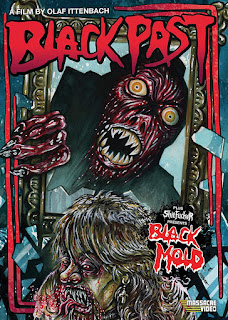Although unfortunately some of the
fanfare tends to come from the cult of irony, the more light shone on
shot-on-video movies the better as such works represent an important
part in evolution of filmmaking. It's been documented countless
times, but the fact remains that not only did the video revolution
make it easier for everyone to watch films in their own homes, but
the accessibility of video cameras made it easier to make their own
films. Of course, given that the majority of SOV movies were amateur
productions the quality of the majority of SOV movies can be rather
shoddy, yet despite the quality, the one trait all SOV films had
was sincerity. That combined with the amateur effect made the movies
feel all the more personal and gave the SOV aesthetic an odd
mystique. While a good chunk of the biggest SOV titles like
Boardinghouse (1982), Sledgehammer (1983), Black Devil Doll from Hell
(1984) and Woodchipper Massacre (1988) were American productions,
Europe had its own movement, the leader of which was Germany's Olaf
Ittenbach. Ittenbach quickly gained notoriety among underground
horror fans due to the extreme gore quotient of his films, chief
among them the infamous The Burning Moon (1992) and later Premutos:
The Fallen Angel (1997) but it was Ittenbach's first feature Black
Past that put his name on the map, a crucial title for both splatter
horror and SOV films.
After moving into a new house with his
father and two nagging sisters, Thommy (Ittenbach), an aimless and
angsty teenager discovers a mirror chained up in a box in the attic
that belonged to the previous owner of the house who went on a
murderous rampage. Thommy hangs the mirror in his room only to
discover the sinister forces it houses when his girlfriend Petra
walks into oncoming traffic after being put into a daze by the
mirror. After reading the diary he found with the mirror, Thommy
finds himself under the mirror's spell, transforming him into
deadly demonic entity.
A labor of love in every sense of the
term with Ittenbach writing, directing, acting, co-producing and
doing the effects, Black Past stands head and shoulders above most
shot-on-video features in every department. What's more, Ittenbach's
previous film work consisted of shorts which he freely admits were
excuses for showcases his effects work and like most SOV flicks,
Black Past was shot mostly on weekends. Although the cursed house
set-up is a familiar one, Ittenbach keeps things fresh and even takes
the film into territories that most SOV features would never attempt
to go. There is a sincere attempt at drama throughout the entire film
revolving around Thommy and his constant feuding with his father and
sisters. Despite Thommy's deadbeat nature, Ittenbach himself has a
certain charm about him and his family's constant harping on him
about everything does make his anger seem a bit more justified. Even
the moments that are an obvious attempt at padding out the run time,
one of the most common occurrences during SOV movies, like scenes of Thommy
wandering aimlessly in stores have an endearing factor to them
because of Ittenbach's emphasis on giving the film a semblance of
emotion. Obviously due to the format the film does run into some of
the technical issues inherent in all video movies, but again
Ittenbach manages to minimize them and thanks to his ingenuity even
gives moments of the film as genuine sense of style and atmosphere,
particularly during the third act when the film becomes a massive
bloodbath.
Being an Ittenbach film, the biggest
selling point is of course going to be the gore with all the effects
created by Ittenbach himself. What may surprise many given
Ittenbach's reputation is how he takes his time with it. There are
splashes of violence in the opening of the film and sprinkled
throughout in the form of hallucination and dream scenes but
Ittenbach saves the big showcase for the films previously mentioned
third act which consists of one big gore set piece after another. Not
only is the gore plentiful (and rather mean spirited with one
particularly savage bit involving one of Thommy's sisters) but more
importantly, it's innovative with Ittenbach coming up with some
pretty astonishing and original ways of filling the screen with as
much blood as possible. It's also crucial to point out that the
effects were 100% practical which, given the resources Ittenbach was
working with, make them all the more admirable. Perhaps the most
impressive would be Thommy's transformation into his fully demonic
form, though there is a showstopping hallucination/dream that
Ittenbach would improve upon with the infamous Hell segment in his
follow-up film The Burning Moon, his most well known work. Ittenbach's
effects skills would eventually find him work on other films, but it
all began with Black Past, a remarkably assured film for a homegrown
debut and really an important entry in the German horror canon.


